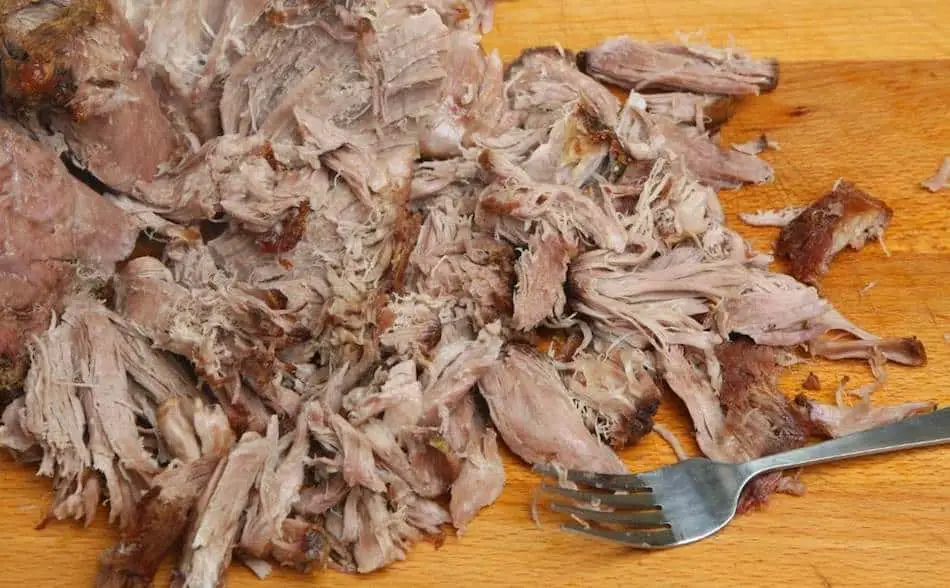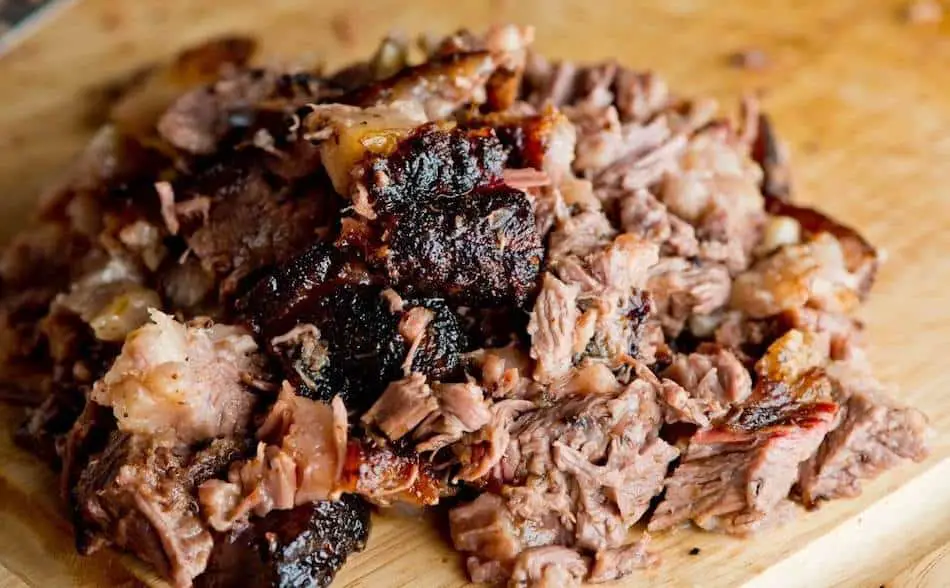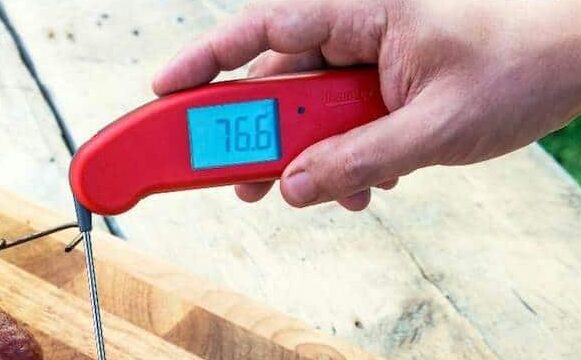
There’s nothing worse than dry, pulled pork. Timing is everything when cooking pork shoulder, so you want to remove it from the smoker at the perfect time so that your pulled pork is tender and juicy.
The ideal done temperature for pulled pork is between 200° F and 205° F internal, although temperature alone isn’t the only indicator. You should also perform a tenderness test with a toothpick or thermometer probe. Once the pork has reached perfect tenderness, it should feel as though you’re poking a stick of butter—no resistance whatsoever.
Quick Tips
- Timing is crucial when cooking pulled pork to ensure it is tender and juicy
- The ideal done temperature for pulled pork is between 200° F and 205° F internal, but temperature alone is not the only indicator
- Tenderness test with toothpick or thermometer probe is the best way to know when the pork is done
- Temperature of 190°F is a good indication that the pork is close to being done
- Pulled pork should be checked for tenderness regularly, once it feels like butter it’s done
- Safe eating temperature for pulled pork is 140°F to 160°F but the meat will be chewy
- Thermometers are an essential tool for smoking pulled pork and should be fast and accurate
- Instant-read thermometer is used towards the end of the cook and a remote leave-in thermometer with multiple probes is useful for monitoring the temperature of the smoker and the meat
- Pork butt/shoulder takes a long time to cook because it is a tough cut of meat with a lot of connective tissue and gristle that needs to break down at a low temperature.
How To Know Your Pulled Pork Is Done
Although many pitmasters say that 203°F is the magic number, there’s no such thing as the perfect internal temperature for pulled pork. Every piece of pork is different. The levels of fat and connective tissue will differ between pork shoulders, so some might need longer than others. Experienced barbecue gurus never go by temperature alone. They also go by look and feel.

Thermometers Let You Know Your In The Ball Park
Thermometers are an essential tool when smoking pulled pork. However, thermometers don’t tell the complete story. A thermometer will give you an idea the meat is getting close to being done, but it won’t tell you when if the pork is tender. Poking the pork with a toothpick is the only way to know if the pulled is tender.
When the temperature goes beyond 190°F, you know you’re getting close. Take a toothpick and begin checking the pork for tenderness. Keep checking until it’s soft as butter. You can also use the probe of your instant-read thermometer to check.
Pulled Pork Safe Eating Temperature
Safe eating recommendation by the USDA for pulled pork is 140°F to 160°F. Even though I pulled pork is safe to eat at this temperature, the meat will be chewy. The collagen and connective tissue would not have softened, so the pork will be tough. Leave your pork in the smoker until it reaches at least 190°F to 200° F, then check for tenderness.
Safe Temperatures According To The USDA
The Importance Of Thermometers
Thermometers are your most important tool if you want perfectly cooked pulled pork. Without a good thermometer, you’re working blind. However, you can’t just get any old thermometer. There are just as many bad thermometers as good ones. If a thermometer is inaccurate, there’s no point in using it. If you’re serious about your barbecuing, then you should have two thermometers; an instant-read, and a remote “leave-in” thermometer.

Instant-Read Thermometer
We use an instant-read thermometer towards the end of the cook. These tools will give you fast readings in multiple areas of the meat. It’s important to check thick and thin parts of the pork because they will cook at different rates. Your thermometer will help your decision making for things such as rotating the meat, wrapping, spritzing, etc.
Not only should instant-reads be fast, they should be accurate—especially when cooking meat high in bacteria such as chicken. Sometimes, you are putting your health at risk if the thermometer is inaccurate.
The market is flooded with cheap instant-reads, and many are wildly inaccurate. If you want a good instant read, I would recommend the TP19 because it’s fast, accurate, and affordable.
Leave-In Thermometers
Your first thermometer should be a remote leave-in thermometer. This thermometer should have at least 2 probes, but you can get away with a single probe if your smoker is easily controlled and holds stable temperatures. The idea with a duel-probe is to monitor the temperature of the smoker/cooker with one probe and track the internal temp of the meat with the second probe. You can but thermometers with six probes, but that’s overkill for the average backyard cook.
I use the TP20 because it inly cost me $50 on Amazon, and everyone on the barbecue forums raved about its accuracy and ease-of-use. And I haven’t been disappointed. Check out the video below for an introduction to the TP20.
Hi-Tech Wireless Thermometers
Nowadays, there are super high-tech thermometers that use Wi-Fi and connect to your phone. With these instruments, you can monitor your meat from anywhere in the world where a Wi-Fi connection is available. MEATER, Airprobe and Meatstick are the best of these ultrahigh-tech thermometers.
If you have an instant-read thermometer, begin checking the pulled pork roast once it hits the 190°F to 195° F range. Check it regularly after that because you don’t want to let it get away from you.
Why Pulled Pork Takes So Long To Cook
Pork butt/shoulder is a tough cut of meat and contains a lot of connective tissue and gristle. In order for this connective tissue to break down, the meat needs a lengthy time at a low temperature. If you were to remove the pork and shred it too soon, the temperature or the meat quality will be chewy and stringy. This is because it hasn’t had a chance to break down.
Tenderness Testing With A Toothpick And Butter
- Place a stick of butter beside the pork.
- Take a toothpick and insert it into the sticker butter. Note how easily the toothpick goes in and out of the butter.
- Take another toothpick and insert it into the pork shoulder. The meat has reached perfect tenderness when they feel similar.
How Long Does It Take To Cook Pulled Pork?
The total cook time pork butt is usually around 1 hour and a half per pound at 225°. So a 5 pound pulled pork will take 7 to 8 hours. If you were to cook a hotter 250°F, it would take just over 1 hour per pound. So a 5 pound pork roast would take around 5 hours.
Resting
Make sure you rest the pork shoulder for about an hour prior to shredding. If you pull the pork shoulder out of the smoker, all the muscles will be tight still and pushing out moisture. If you were to slice the pork at that temperature, all the moisture will be lost and your shoulder pork will be dry. Give the pork butt time to rest, so there’re muscles relaxed, and it will reabsorb some of that moisture.
Holding
If you’re not ready to shred your pulled pork, you can place the pork into holding. Check out this post on holding pork butt in a cooler.
Holding is when is like resting, except you place the meat in a dry cooler where it will stay hot for up to 4 or 5 hours. This is a great way to help you with your planning, because it will hold at a hot, safe internal temperature for many hours. Leave a thermometer probe in the meat. That way, you can keep track of the temperature. As long as it doesn’t get below 140°F, it’s a safe eating temperature.
Wrapping
If you choose not to wrap your pork, it’s going to take much longer to cook. Wrapping will not only speed up the cook, it will also help your shredded pork to stay moist. Wrapping will help you push your pork through the stalls, which usually occurs at around 3/4 of the way through the cook.
The Stall
One thing that will prevent your pork from reaching the dun temperature is the stall. This happens with pork and any other large cut of meat cooked low-and-slow. Simply put, the stall happens after the meat sweats. The moisture cools the meat and brings cooking to a standstill. The stall can be extremely frustrating. The pork might remain in the stall for several hours, and even may even go backwards.
If you’re prepared for the stall, it isn’t as frustrating. You can work it into your planning. You can beat the stall by wrapping the pork in foil during the second half of the cook, or you can increase the temperature of your smoker. The stall usually occurs when the meat reaches around 160° F to 170° F. Somewhere within that range, the temp will plateau.
Some thermometers like the Fireboard 2 have great graphing, and you can look back over your cooks and you can see the stall on a graph. MEATER also has graphing abilities where you can actually see the stall visually—which is very interesting.
Have you seen the most advanced thermometer on the market? FireBoard can be controlled via your phone, holds meat 6 probes, and records your cook data on a cloud.
My Favorite Meat Smoking Tools
Thanks for checking out this article. I hope you learned a few things. Here are some of my favorite tools I use when smoking brisket that may be useful to you. These are affiliate links, so if you decide to purchase any of these products, I’ll earn a commission. But in all honesty, these are the tools I recommend to my family and friends who are just starting out.
Meat Thermometer: There are dozens of fancy thermometers on the market, but I still use my trusty TP20. For around $50, I have a high-quality meat thermometer with two probes, and can track the temperature of my smoker with one probe, and my meat with the other probe. The ThermoPro TP20 is an Amazon Best Seller because it’s the easiest thermometer to operate, is durable, highly accurate, and comes with pre-programmed meat settings.
Instant Read Thermometer: Arguably, the second most important tool you need is a fast and accurate instant-read thermometer. These tools play an important role in the latter stages of the cook when the meat needs regular checking in multiple areas. I use the ThermoPro TP19 because it can do everything a ThermaPen can do, but for a fraction of the cost. You can check out the TP19 on Amazon here.
Wireless Thermometer: The latest thermometers on the market have no wires and can be controlled by wi-fi via your phone. Airprobe 3 is the best of this technology.
Butcher Paper: Wrapping brisket in butcher paper has become a huge trend in barbeque thanks to Aaron Franklin. Wrapping your brisket in paper will give you a nice brisket bark. However, you can’t just use any old paper, it has to be unwaxed, food grade paper. You can find it on Amazon here.
Advanced Thermometer and Automatic Temperature Controller: Once you’re ready to take things seriously, the FireBoard 2 Drive is a six-channel Bluetooth/Wi-Fi thermometer that can monitor up to 6 pieces of meat, control and graph your cook sessions on your smartphone, and attaches to an an automatic blower that will convert your charcoal smoker to a set-and-forget. This is one of the most advanced meat thermometers on the market. You can check it out on the FireBoard website here.
